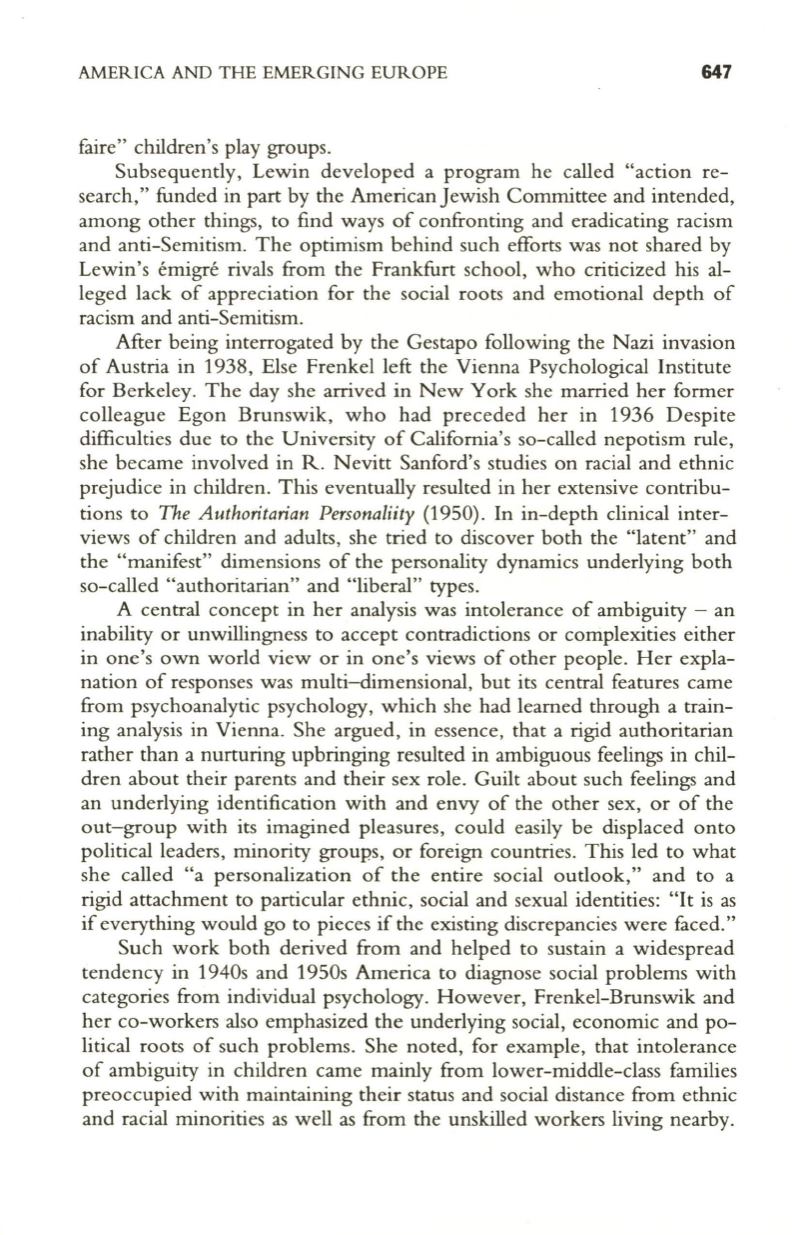
AMERICA AND THE EMERGING EUROPE
647
faire" children's play groups.
Subsequently, Lewin developed a program he called "action re–
search," funded in part by the American Jewish Committee and intended,
among other things, to find ways of confronting and eradicating racism
and anti-Semitism. The optimism behind such efforts was not shared by
Lewin's emigre rivals from the Frankfurt school, who criticized his al–
leged lack of appreciation for the social roots and emotional depth of
racism and anti-Semitism.
After being interrogated by the Gestapo following the Nazi invasion
of Austria in 1938, Else Frenkel left the Vienna Psychological Institute
for Berkeley. The day she arrived in New York she married her former
colleague Egon Brunswik, who had preceded her in 1936 Despite
difficulties due to the University of California's so-called nepotism rule,
she became involved in R. Nevitt Sanford's studies on racial and ethnic
prejudice in children. This eventually resulted in her extensive contribu–
tions to
The Authoritarian Personaliity
(1950).
In
in-depth clinical inter–
views of children and adults, she tried to discover both the "latent" and
the "manifest" dimensions of the personality dynamics underlying both
so-called "authoritarian" and "liberal" types.
A central concept in her analysis was intolerance of ambiguity - an
inability or unwillingness to accept contradictions or corriplexities either
in one's own world view or in one's views of other people. Her expla–
nation of responses was multi-dimensional, but its central features came
from psychoanalytic psychology, which she had learned through a train–
ing analysis in Vienna. She argued, in essence, that a rigid authoritarian
rather than a nurturing upbringing resulted in ambiguous feelings in chil–
dren about their parents and their sex role. Guilt about such feelings and
an underlying identification with and envy of the other sex, or of the
out-group with its imagined pleasures, could easily be displaced onto
political leaders, minority groups, or foreign countries. This led to what
she called "a personalization of the entire social outlook," and to a
rigid attachment to particular ethnic, social and sexual identities: "It is as
if everything would go to pieces if the existing discrepancies were faced."
Such work both derived from and helped to sustain a widespread
tendency in 1940s and 1950s America to diagnose social problems with
categories from individual psychology. However, Frenkel-Brunswik and
her co-workers also emphasized the underlying social, economic and po–
litical roots of such problems. She noted, for example, that intolerance
of ambiguity in children came mainly from lower-middle-class families
preoccupied with maintaining their status and social distance from ethnic
and racial minorities as well as from the unskilled workers living nearby.


